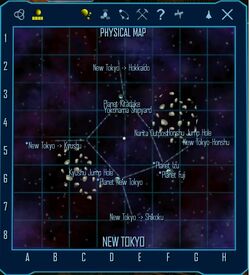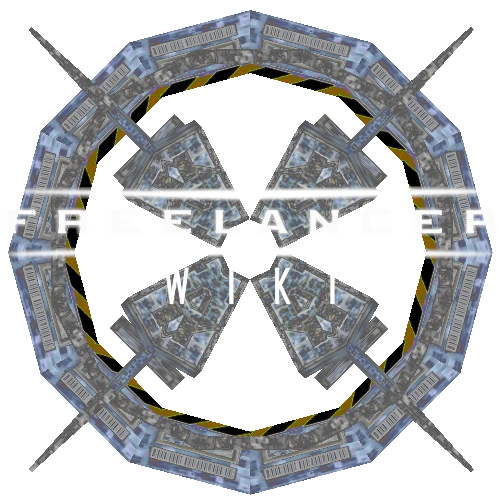
New Tokyo System
The capital of the Kusari Empire, the New Tokyo system receives shipments from all over Sirius. The system hosts the headquarters of the two mighty keiretsu -- vast corporate networks -- Kishiro and Samura.
Planets[]
New Tokyo[]
Settled in 5 AS, New Tokyo is the capital of the Kusari Empire and, with nearly two hundred million people clinging to its scattered islands, its most populous planet. Despite -- or perhaps because of -- this crowding, New Tokyo is a vibrant world with centuries of history and some of the most advanced technology in the colonies. It is also a culture in transition, as bureaucrats and corporations wrestle with the best ways to manage the rapidly increasing pace of change. To accomplish this difficult task, the Kusari ruling body, the Shogunate, works closely with corporate keiretsu -- such as Samura and Kishiro -- to advance the interests of the Empire while safeguarding the heritage of the Kusari people.
Izu[]

Kusari, New tokyo system, Planet Izu
Small moon only composed of frozen methane around a rocky core. The danger that these pockets of methane represent prevented any development.
- DIAMETER: 4458 km.
- MASS: 2.43 x 10e24 kg.
- TERRAIN: Ice
- TEMPERATURE: -72° C to -54° C
- ESCAPE VELOCITY: 3.98 km/sec
Fuji[]

Kusari, New tokyo system, planet Fuji
One of the largest gas giants ever discovered in the sirius sector, Fuji's impressive gravitational well prevents any exploitation of its resources. Shinagawa station, Kishiro's HQ, is in orbit around the planet within sight of its superb rings.
- DIAMETER: 31121 km.
- MASS: 14.02 x 10e24 kg.
- TERRAIN: N/A
- TEMPERATURE: N/A
- ESCAPE VELOCITY: 24.26 km/sec
Kitadake[]
A large gas giant whose ring system provides a scenic backdrop to the orbiting complex of the Yokohama Shipyards, but which otherwise lacks any useful resources.
Bases[]
Narita Outpost[]

Narita Outpost
After Jump Gates linked New Tokyo with the other colonies, the Kusari Shogunate decided that the resulting influx of foreign traffic needed careful management. As a result, Narita Outpost was constructed to serve as the final destination for all shipments to New Tokyo and as a base of operations for the major foreign shipping firms, primarily Republican Shipping, Bowex, and Gateway Shipping.
Roppongi Station[]

Roppongi Station
In the early years of the Kusari Empire, foreign immigration was strictly controlled and permanent foreign settlements on New Tokyo were strictly forbidden. While the Kusari Shogunate was unwilling to bend these rules, it still accommodated foreign business interests by constructing Roppongi Station in orbit. Since that time, Roppongi has largely become home to elite expatriates from New York and New London who have long-term business to conduct in the system. The station is also a popular destination for New Tokyo youths wishing to sample its entertainment concourses. Interspace Commerce (IC) maintains an office on board to oversee its interests in the system.
Kabukicho Depot[]

Kabukicho Depot
Hogosha translates literally as "guardian" or "protector," reflecting the organization's rather romantic view held not only by its own members, but by a large portion of the Kusari population -- though by no means the majority. Far from protectors, the Hogosha are actually descendants of the organized crime syndicates that grow within the shadow of any sizable human society -- though the Hogosha have an oddly symbiotic relationship with both the government and Samura. Their political connections would make any serious attempt to dismantle them an embarrassment to Kusari as any number of secrets and deals that had been kept out of the public eye came to light. However, neither do the Hogosha have a free license to operate. Arrests of low-level Hogosha operators who flaunt their activities are frequent and help keep up appearances -- very important in Kusari. "Hard" crime, such as drug smuggling, is not tolerated. Individual opinions vary, but most police consider the Hogosha a necessary evil required for the smooth functioning of Kusari society. The government simply treats the Hogosha like any other large keiretsu. The Kusari population as a whole has a similar attitude: It is pointless to like or dislike the Hogosha; they are simply a fact of life. The Hogosha handle Artifact and gun smuggling and the fencing of stolen goods. They also do occasional dirty work for Samura. They view the Blood Dragons as a major threat to their existence and have engaged in turf wars with them, mostly in the asteroid fields of Tokyo. The Golden Chrysanthemums are a new problem, as they have few qualms about dealing in the drug trade or its consequences. Since they have no corruptible leaders or long associations with Samura or the Kusari government and police, the GC -- like the Blood Dragons -- are dangerous to the Hogosha way of life. They view the Junkers as their only real competitors within the Sirius Sector, and their only obstacle to expansion into the other Houses. They have approached the Corsairs to assist them in their plan, although no concrete steps have been taken. The Hogosha made a recent arrangement to purchase Artifacts directly from the Corsairs on the cruise ship Hawaii, a move that infuriated the GMG, who formerly served as the middleman between the two crime syndicates. It also raised the ire of the LSF, who applied pressure on Orbital Spa to deny landing privileges to the two factions.
Shinagawa Station[]
Shinagawa Station is the headquarters for Kishiro, one of the two largest keiretsu -- vast corporate networks -- in the Kusari Empire. While not as politically well-connected as their primary competitor, Samura, Kishiro has instead focused its efforts on developing cutting-edge technology. Its most notable breakthrough was in 91 AS when scientists working aboard Shinagawa perfected the mass production of Optical Chips using a common Polymer base. These Optical Chips have since become key components in everything from Optronics to ships to Jump Gates and Trade Lanes.
Shinjuku Station[]

Shinjuku Station
Shinjuku Station is the corporate headquarters for Samura, the oldest of the keiretsu -- vast corporate networks -- in the Kusari Empire. The history of Samura is deeply intertwined with that of the Empire, and Samura maintains close ties with the Kusari Shogunate, its ruling governmental body. Samura holds key contracts for the construction of the Kusari Navy and terraforming in the Tau Border Worlds, and previously held the exclusive rights for the distribution of valuable resources produced by the Gas Mining Guild (GMG). However, because the agreement with the GMG has recently expired, Samura faces intense competition for the GMG's business from archrival Kishiro. Samura is also engaged in a protracted dispute with Synth Foods over the lucrative race to feed the ever expanding Kusari population.
Yokohama Shipyard[]

Yokohama Shipyard
Constructed in 50 AS by Samura, Yokohama Shipyards was the first orbital construction facility built in Kusari. While Samura has been forced to cede the construction of gas transports and miners to archrival Kishiro, Yokohama still does a bustling business building large orbital habitats to house the overflowing New Tokyo population and servicing the ships of the Kusari Navy.
Jump Gates/Holes[]
Fields[]
Kanto Field[]
An asteroid field mined out centuries before during the initial Kusari burst of expansion. The field is entirely deserted today except for Kabukicho Depot, where the Hogosha endeavors to "protect the anonymity of their clients." Police patrols have recently been increased as terrorist groups such as the Blood Dragons and Farmers Alliance have been using the field to launch strikes against targets uncomfortably close to New Tokyo itself.
